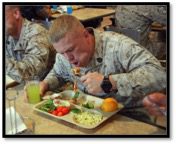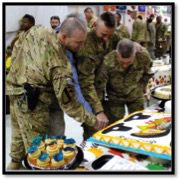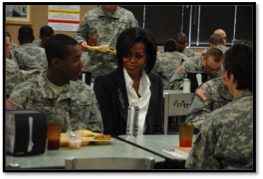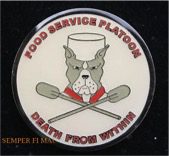
Convoys to the Front – LOGCAP personnel demonstrate ingenious resourcefulness in supplying US forces, wherever they are.
Peter Adam
RECENT UPDATE: On November 20, 2017 the Contracting Office released the RFP. Proposals are due no later than 5:00 PM LT on January 22, 2018.
For immediate proposal support please click here.
On April 14, the draft RFP for the latest incarnation of the gigantic ($82B ceiling) LOGCAP V – Army Logistics Civil Augmentation Program — hit the street.
LOGCAP V’s forbearers (particularly LOGCAP III) have been maligned — often, and often unfairly. That’s because LOGCAP’s storied past is only partially known to the public.
LOGCAP V is a continuation of the Army’s contingency support program. It involves provision of housing, materiel, operations and maintenance services, etc. – food . . . and, of course, beverages. But it’s not everyone’s cup of tea.

Napoleon Was Right – An army marches on its stomach. Soldiers seem to enjoy scarfing down chow prepared by LOGCAP contractor personnel.
Readiness to Roll
Faint of heart desk warrior “FOBits” (those who remain huddled in the protected confines of comfy Forward Operating Base digs) need not apply. LOGCAP contractor personnel have to be ready to go outside the wire and head for the front lines, pronto, especially now. With version V, the watchwords are: Sprint and RAPID RESPONSE. In prior versions of the program, contractors tapped for LOGCAP duty had a leisurely 30 – 180 days to respond to TORPs. Now, that’s been shortened, big time, to . . . – 96 HOURS! And, similarly, they have to be ready spring into action IMMEDIATELY.
Specifics
LOGCAP V is a Facilities Support Services IDIQ contract, to be performed OCONUS — 10 year (base) with TO’s issued on various pricing bases – FFP, Cost Plus, etc. Six awards are expected.
LOGCAP’s principal objective is providing Combat Support and Combat Service Support (CS/CSS) to Army commanders during contingency operations over a full range of military operations. LOGCAP services are authorized for supporting other service arms, coalition and/or multinational forces, as well as other governmental/non-government agencies.
The Supply Operations, Field Services, and Other OPNS & Services required globally include:
o Minor Construction
o Refurbishment
o Wells Maintenance
o Facilities Management, e.g. roads and grounds Services, perimeter fencing
o Clamshell/Tent Repairs
o HAZMAT Management/Storage

ELEGENT DINING – LOGCAP contractors are called upon to serve soldiers under primitive conditions.
o Vector & Pest Management Services
o Laundry Service Operations
o Food Service Operations
o Morale, Welfare, and Recreation (MWR) Services
o Power Generation Services
o Water Production Services
o Billeting Maintenance
o Waste & Sewage Management
o Material Handling Equipment (MHE) Operations
o Reefer Maintenance
o Vehicle Maintenance
o Agricultural Cleaning
o Transportation Motor Pool Operations
o Class III Retail Operations
o Fire Fighting & Protection Services
o Oxygen Generation Operation & Maintenance
o Postal Services
o Material Yard Operations
o Forward Redistribution Point (FRP)
o Supply Support Activity (SSA)
o CLASS I Yard Operations
o Airfield Operations & Management Services
o Theater Transportation & Theater Movement Control
o Container & Cargo Management
o Janitorial Services
o Redeployment Staging Base Operations
The New LOGCAP Normal

VIP READY – LOGCAP facilities sometimes host festivities attended by distinguished guests. Under LOGCAP III, 78.9 million bags of laundry were cleaned, 1.1 billion meals prepared, And 239.2 million patrons visited MWR (Morale, Welfare and Recreation) facilities.
The rapid response capability now required of LOGCAP V contractors was illustrated by an important and highly
successful, operation recently carried out by AFRICOM. Unfortunately press coverage of Operation Observant Compass, which wound up last March 24, was negligible. Regardless, this military action completely degraded the military capability of the brutal warlord Joseph Kony. Kony’s Lord’s Resistance Army (LRA) has killed more than 100,000 people and kidnapped 60,000 children in a three-decade-long rebellion spanning northern Uganda, South Sudan, the Central African Republic, and the Democratic Republic of the Congo.
Support for this exemplary operation was provided under the existing LOGCAP arrangements. The efficiency with which support services were provided are illustrative of the performance standards that LOGCAP contractors will be required to meet in LOGCAP V. Response was immediate. Existing arrangements were properly leveraged. Contractor personnel became involved in planning from the get go. Three separate operational components were supported simultaneously. This level of performance is what LOGCAP V bidders will have to show they’re capable of.
Yesterday, Today, and . . . Tomorrow
For 28 years now LOGCAP has successfully supported the Army and DoD by augmenting the Commander’s logistics capability with commercial service providers to offset Combat Service Support (CSS) shortfalls. This program has successfully executed rapid, small-scale contingency support to PACOM, AFRICOM, and CENTCOM, and has, additionally, successfully managed and executed multi-billion dollar, major, long-term operations for CENTCOM. The history of the LOGCAP program is covered in the table below.
LOGCAP History
| LOGCAP History | ||||
| Version | Contractor(s) | Authority | Place of Performance | Price |
| LOGCAP I (1992 – 1996) | Single Award (SA)– Brown and Root (later became part of KBR) | Ad hoc — US Army Corps of Engineers (USACE) | Southwest Asia (SWA) Pipeline System, Somalia, Balkans | $815M |
| LOGCAP II (1997 – 2001) | SA –Manager: AMC/CECOM – Operator: DynCorp | USACE | East Timor, Philippines, and Columbia | $42B |
| LOGCAP III (2002-2011) | SA – Manager: AMC/ AFSC – Operator: KBR. | Army Materiel Command (AMC) | Afghanistan, Kuwait, Iraq, Djibouti, Georgia, Uzbekistan | $40B |
| LOGCAP IV (2010 – Present) | MA – (3 performance contractors) — SA Program Manager: AMC/ASC — Contract Manager: ACC-RI – Operators: KBR, Fluor, DynCorp operators – Support: Jacobs
|
AMC | Iraq, Afghanistan, Africa, UAE | $14.4B |
| LOGCAP V | 6 Awardees | AMC | Wherever Support for US Military is Needed — OCONUS | $82B (ceiling) |
| LOGCAP FACTS
35.6B gallons of water produced 9.5B gallons of fuel Issued (bulk/retail) 1.6B meals prepared 1.3B APOD, cargo arrivals & offloads 471.7Mlbs of mail handled 306.8M patrons visited MWR facilities 268.5M tons of ice produced 196.6M miles driven in support of forces 113.3M bags of laundry cleaned 15.9MMHE (crane/RTCH/forklift) missions 6.2MAPOD, personnel arrivals & departures 3.2M SPOD, Containers loaded & offloaded (Contractor Casualties: Killed – 130; wounded 474) |

THE CHALLENGE – Notwithstanding the feeble attempts of humor made by not-so-clever challenge coin designers, and all kidding aside, LOGCAP has been an effective vehicle in provisioning US forces.
Using contractors instead of organic military assets for support services has come under fire as too expensive. Yet the economics of this type of contracting, in addition to long-term trends, are in LOGCAP’s favor. A reasoned, dispassionate analysis of the biggest task order under LOGCAP III –Task Order 59, which supported 130,000 U.S. ground troops in Iraq from 13 June 2003-12 June 2004 bears this out. Organic Army support would have been 90 percent more expensive, weighing in at an estimated $78B – the cost of LOGCAP-provided services, a far more modest $41B — the actual price tag for this TO effort.
This type of contracting is part of a long-term trend looks to be with us for the foreseeable future. As the Defense Science Board has noted, “The trend is clear that the use of contractors to support military missions on the battlefield has risen over the past 200 years. The extent that contracted support was used in recent conflicts is remarkable… for the majority of the duration of each contingency conflict, the number of contractor personnel was equal to or larger than the deployed military personnel. At one point there were over 160,000 contingency contractor personnel in Iraq.”
Winning the Contract
Those who want to bid on – and win — LOGCAP V business should demonstrate the following qualities and capabilities in the solutions they provide in their submissions:
Responsiveness — Agile sustainment for an agile force; sustainment available where and when needed.
Transparency — Costs traceable to execution.
Affordability — Effective measures to control costs and ensure best value.
Predictability — High confidence of cost predictability when Levels of Effort are known.
Capability — Full spectrum sustainment capabilities across the full range of possible mission sets.
Flexibility — Rapid expansibility and reversibility to meet commander’s objectives.
Accountability — Adherence and compliance with regulatory and contractual requirements.





I have experience of 19 years in 5 international organizations including Afganistan. I have a lot of diplomas and recommendations. I have experience as a armoured vehicle driver/security and as a mechanic.